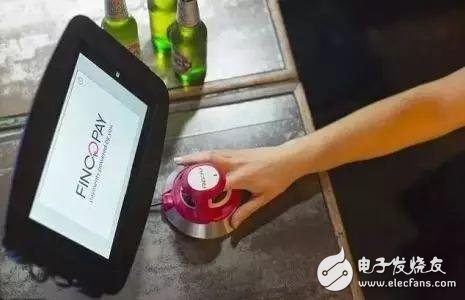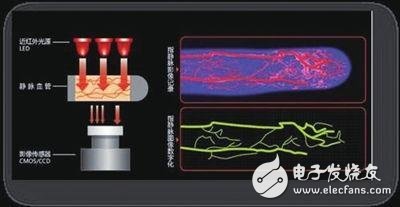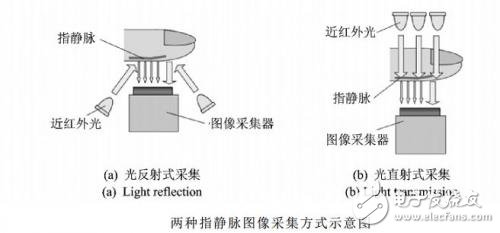Vein recognition technology, three minutes tells you it is å•¥
In fact, more and more biometrics have come into our lives, including some ways to identify them unexpectedly. Recently, some media reported that in a bar in London, the customer only needs to scan the index finger to check out. Don't think that this is a new fingerprint scanning function, in fact, it scans deeper - the veins under the skin. This technique is called vein recognition technology.
At checkout, they simply put their index finger on the scanner and they receive a bill at the email address. How is the secret vein under near-infrared light "detected"? How is the uniqueness of identification?

Vein recognition is an emerging infrared biometric technology. It is based on the characteristics of deoxygenated hemoglobin in the venous blood to absorb near-infrared rays or far-infrared rays radiated by the human body. Infrared cameras of the corresponding wavelength range are used to ingest the back of the hand (or the back of the fingers, the abdomen, the palms, The vein distribution map of the wrist is pre-processed by normalization, denoising, filtering enhancement and vein pattern segmentation, refinement and repair, and then extracting its features, and then registering with the database or the feature data stored on the IC card. Match to determine personal identity. Because each person's vein map has the characteristics of being unique to the fingerprint and persistent in adulthood, it can uniquely identify a person's identity. In addition, it has the advantages that other biometrics technologies do not have, so it has broad application prospects and has attracted the attention of scholars.

Vein recognition is divided into: finger vein recognition and palm vein recognition. The palm vein has more slow veins due to preservation and contrast. Finger vein recognition, because of its large capacity, recognition speed, but both have the advantages of high precision, living recognition, etc., have different advantages in access control security. In short, the finger vein recognition response is fast and the palm vein safety factor is higher.
1, finger vein technology advantage
Finger vein technology has several important features that make it far superior to other biometrics in terms of safety and ease of use. Mainly reflected in the following aspects:
High security:
The vein is hidden inside the body and is less likely to be copied or stolen.
Easy to use:
The user's psychological resistance is low, and the factors affected by the physiological and environmental factors are also low, including: dry skin, oil stains, dust and other pollution, abnormal skin surface.
Highly accurate:
The falsification rate is 0.0001%, the rejection rate is 0.01%, and the registration failure rate is 0%.
Quick identification:
The original finger vein image was captured and digitized, and the image alignment was performed by Hitachi's proprietary finger vein extraction algorithm, which took less than one second.
2, palm vein technical advantage
The palm vein utilizes the characteristics of near-infrared light when the human hemoglobin passes through the vein, and collects the vein image under the palm skin and extracts it as a biological feature. Compared with other biometric technologies such as fingerprints, irises or hand shapes, the palm vein is extremely difficult to copy and counterfeit. The biggest reason is that this biological feature is under the palm of the hand and cannot be seen by the naked eye. In addition, since the palm vein is used in a non-contact manner, it is more hygienic and suitable for use in public places. At the same time, the application of the palm is also more natural, making it easier for users to accept. The false rate and rejection rate of the palm vein are also lower than other biometric technologies.
Compared with other recognition technologies, the study of finger vein recognition began around 2000, with a late start and development is not mature enough. However, in the long run, the advantages of this technology make it a huge market potential.
Finger vein identification technology system1, the principle of finger vein imaging
First of all, we must explain the blood vessel veins distributed in our fingers. Medical research shows that the veins of each of our fingers are unique in the world, the right and left hands are different, and the twins are different. The reason why the finger vein is used is because the vein is closer to the skin of the human skin than the artery, and it is easier to collect. In addition, the veins have more curves and branches than the arteries, and the acquired vein image features are more obvious. By using near-infrared rays to illuminate a finger, hemoglobin in the venous blood absorbs near-infrared rays, and muscles and bones are weakened, resulting in a conspicuous image.
2, the collection of images
In the aspect of vein imaging, there are two types of imaging device photosensitive sensors currently on the market: CCD and CMOS. The CCD device uses the photoelectric effect to collect the charge, which is transferred to the analog shift register with the clock signal and converted into a voltage in series. However, this requires a very high sensitivity and signal-to-noise ratio and a good dynamic range, which makes the CCD production process complicated and expensive. In contrast, CMOS is cheaper, has higher integration, and lower power consumption. Although there is no CCD excellent in the quality of imaging, the spectral sensitivity range of CMOS is 5 to 6 higher than visible light in the near-infrared segment. It is more suitable for capturing images under infrared light, so overall COMS is more suitable.
The near-infrared range is generally selected to be around 850 nm, and the portion of the vein transmitted at this wavelength is small, and the imaging is remarkable. However, due to the inevitable exposure to the lighting environment in the use environment, this may cause instability of the finger vein imaging, so we also need to add infrared filters to eliminate interference from visible light as much as possible.
3, image processing
In addition to the influence of illumination, the acquired image will be noisy, and the image will be affected by the position and posture of the finger and other factors, so the collected image needs to be further processed.
The processing methods generally include: denoising processing, image area cropping, size or grayscale normalization, image enhancement, filtering processing, image segmentation, position calibration, refinement, and the like. These image processing methods can be selectively employed according to actual needs.
Several of these treatment methods are more important:
Image enhancement, the thickness of different human fingers is not the same due to the difference of individual users. The original image is also affected by the salt and pepper noise (impulse noise), which makes it difficult to segment the subsequent image, so the image needs to be enhanced before the image is segmented.
For denoising, it is necessary to denoise the acquired image, and the image can be smoothed by means of mean filtering. The mean filtering is mainly neighborhood averaging. For each pixel of the noisy original image (assumed to be f(x, y)), a template is selected. This template is composed of adjacent m pixels, and then the average is obtained. The mean is assigned to the current pixel, which is the final pixel value of the pixel. The formula is as follows:
g(x,y)=1/m ∑f(x,y)
Image area cropping, when collecting finger vein images, it will inevitably contain redundant data such as image background. In order to avoid the interference of redundant data, we need to locate the image area, the most commonly used to extract the target object. The method is image thresholding, which is suitable for the case where the target object and the background occupy different gray level ranges in the image. The amount of data is greatly reduced while simplifying the analysis and processing steps. By setting a plurality of thresholds corresponding to different features, image pixel points can be divided into several categories. Commonly used features include grayscale and color features directly from the original image and features derived from the original grayscale or color values. Set the original image to f(x, y), find the eigenvalue T in f(x, y) according to the established criteria, assign 0 and 1 respectively to mark the background and destination object of the image, and divide the image into two parts. That is, image binarization.
Image segmentation can be roughly divided into four types according to different image segmentation methods:
(1) methods using image grayscale statistical information, such as one-dimensional histogram threshold and two-dimensional histogram threshold;
(2) Image segmentation methods using image space region information and spectral information, such as growth method, multi-spectral image segmentation, texture segmentation, etc.;
(3) The edge detection method utilizes the region information information with the strongest gray level change in the image, such as the Canny algorithm; (4) the pixel classification method is a method for image segmentation using image classification technology, such as statistical classification method, Fuzzy classification methods and neural network methods.
4, finger vein feature point extraction
The acquired image can be processed to obtain further vein images. The difference between different vein images lies in the topological structure of the vein and the details. Therefore, it is most appropriate to use the details to represent the identity, and the extraction of the minutiae points generally has the following types:
Endpoint:
It occurs when the finger vein is not deep enough in the inside of the finger or the near infrared ray is transmitted deep enough.
Bifurcation point:
Appears when a single segment of vein divides into two segments of vein.
Double bifurcation point:
It will appear when the two bifurcation points are close together.
The method of feature extraction based on the above three minutiae points is as follows:
Extract endpoints:
Extract a range of N*N (the value of N as appropriate) around the endpoint, and then delete the point in the range that is not connected to the endpoint. Calculate the number of connections between the feature and the range boundary. If the number is a detail point, the detail point is used as the endpoint and the angle of the point and the horizontal line is saved. Otherwise, it does not hold.
Extract the bifurcation point:
Extracting a range N*N centered on a bifurcation point (the value of N depends on the case), and then deleting the point in the range that is not connected to the bifurcation point, and calculating the feature and the number of connections of the range, when When the number of connections is four, it is considered that the bifurcation point is a bifurcation point, and the angle between the branches is saved, otherwise it is not established.
According to the above method, feature extraction can obtain better venous feature recognition effect.


Although the current finger vein recognition is not well known to the public like fingerprint recognition, the finger vein market is currently in a critical state. Once further improved and promoted, it is believed that it will be popularized in various fields in the near future, and even Will lead the direction of information security. Just like the callers who lost their waists and switched to mobile phones more than a decade ago, the finger vein recognition will shine!
The Smart Screen Protector Cutting Machine can help stores reduce the inventory of Screen Protectors. It is mainly used to cut Screen Protectors such as Mobile Phone Screen Protectors, Watch Screen Protectors, Tablet Screen Protectors, Pad Screen Protectors, and personalized fashion Back Films. It is very suitable for personal business or shop drainage.
Universal Screen Protector Cutting Machine has 20000+ cloud data of different specifications and models, adopts massive cloud database, and all data is updated synchronously in the state of networking. You'll have a full range of screen protector models on one machine and cut any Screen Protector model as needed without having to stock up on Screen Protectors for various phone models. No more losing customers due to missing models.
Screen Protector Cutting Machine,Protective Film Cutting Machine,Back Sticker Cutting Machine,Phone Sticker Cutting Machine, Film Cutting Machine
Shenzhen Jianjiantong Technology Co., Ltd. , https://www.jjtbackskin.com
